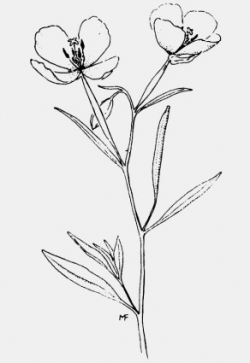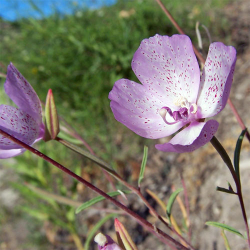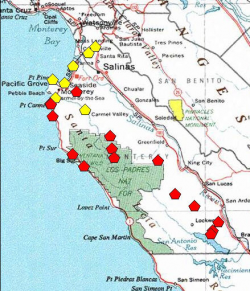
threatened


Photo © 2002 Brian LeNeve

A red polygon indicates an extant occurrence; yellow indicates the occurrence has been extirpated.



This fact sheet was prepared by Dylan M. Neubauer and Dr. Dean W. Taylor under award NA04N0S4200074 from the National Oceanic and Atmospheric Administration (NOAA), U.S. Department of Commerce (DOC). The statements, findings, conclusions, and recommendations are those of the authors and do not necessarily reflect the views of the NOAA or the DOC.
© Copyright 2006, Elkhorn Slough Coastal Training Program
Last updated: Sep 26, 2007 20:05
Common Names - Jolon farewell-to-spring
Family - Onagraceae (Evening-primrose Family)
State Status - none
Federal Status - none
Habitat
Edges and recently burned stands of chaparral, coastal scrub, or oak woodland; ± 500 m.
Key Characteristics
Erect annual herb < 6 dm tall, stems glabrous, glaucous; leaf blades narrowly lanceolate to lanceolate, 3–5 cm, petiole < 5 mm; inflorescence axis in bud straight, buds reflexed; hypanthium 2–3 mm; sepals staying fused in 4s, corolla bowl-shaped, petals 1–2 cm, fan-shaped, pale lavender to pink-lavender, generally red-flecked; stamens 8, outer anthers lavender, inner smaller, paler; stigma exceeding the anthers at anthesis; seeds gray (Lewis 2013). Similar flowers to C. lewisii (with which it is occasionally sympatric), but in C. jolonensis the stem is erect above the open flower with buds nodding over and spaced apart, whereas in C. lewisii the stem turns down immediately after the open flower and the nodding buds are very close together (LeNeve 2015).
Flowering Period
April to June
Reference Population
Arroyo Seco (Monterey County).
Global Distribution
Endemic to the Santa Lucia Mountains (Monterey County).
Conservation
Closely related to C. lewisii, C. bottae, and C. cylindrica ssp. cylindrica. C. lewisii can grow sympatrically with C. jolonensis and can be confused with it, especially late in the season if no flower buds are present or if the plant is small. The primary difference between the two species is that in C. jolonensis the stem is erect above the open flower with the buds nodding over and spaced apart. In C. lewisii the stem turns down immediately after the open flower and the nodding buds are very close together (LeNeve 2015).
This plant was collected several times prior to the 1930s in the vicinity of Seaside and Castroville, where now presumed extirpated. Large areas of suitable habitat require field surveyd. Though 16 locations have been documented, only four and possibly five have been relocated in the recent past. It is thought that some of these locations refer to C. lewisii (LeNeve 2015).
References
CNPS, Rare Plant Program. 2010. Clarkia jolonensis, in Inventory of Rare and Endangered Plants (online edition, v8-02). California Native Plant Society, Sacramento, CA. http://www.rareplants.cnps.org/detail/164.html [accessed 5 February 2015].
Parnell, D. R. 1970. Clarkia jolonensis (Onagraceae): a new species from the Inner Coast Ranges of California. Madroño 20(6):321–323.
LeNeve, B. 2015. CNPS Monterey Bay Chapter. Endemic Plants: Clarkia jolonensis: Jolon clarkia. http://www.montereybaycnps.org/ClarkiaJolonensis.pdf [accessed 5 February 2015].
Lewis, H. 2013. Clarkia, in Jepson Flora Project (eds.). Jepson eFlora, http://ucjeps.berkeley.edu/eflora/eflora_display.php?tid=19583 [accessed 5 February 2015].
Lewis, H. and M. E. Lewis. 1954. The genus Clarkia. University of California Publications in Botany 20(4):211–392.
